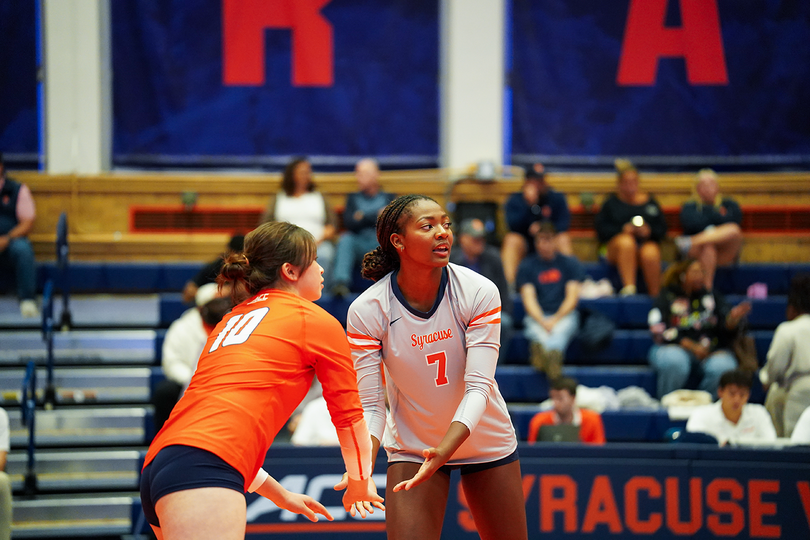SU establishes rhythm early in straight-sets win vs. Le Moyne

By starting its sets strong on Sunday, Syracuse cruised to its third straight win and a sweep of the Salt City Classic. Joshua Greene | Contributing Photographer
Get the latest Syracuse news delivered right to your inbox. Subscribe to our sports newsletter here.
On Oct. 17, 2020, Syracuse held Atlantic Coast Conference foe Boston College to just nine points in the second set en route to a dominant straight-sets victory. Two years later, Bakeer Ganesharatnam took over as SU’s head coach.
Now into his fourth year, the Orange had not held an opponent to under 10 points during his tenure until Sunday.
All it took, Ganesharatnam believes, was getting into a rhythm early, as 128 games later, the Orange did it twice in a single game.
On Saturday, Ganesharatnam voiced his displeasure with the team failing to find cohesion, which allowed Rider to gain momentum and win the third set. Against both Rider and Niagara, the team also trailed at one point in the first set.
On Sunday, however, Syracuse (3-0, 0-0 Atlantic Coast) held Le Moyne (1-2, 0-0 Northeast Conference) to nine points in the first set. SU used that explosive start to cruise to a straight-sets victory and finish the Salt City Classic 3-0.
“I think it all starts with making sure we warm up with the right mindset and we pay attention to details,” Ganesharatnam said postgame.
The Orange blitzed Le Moyne out of the gate, opening the match with a 12-4 run and never relinquishing the lead. Gabby McLaughlin starred again, with four kills in the first set, including a spike that landed just inside the back left corner to make the score 21-7.
But Ganesharatnam credited McLaughlin’s former Nevada teammate, Tehya Maeva, for “creating that rhythm from the get-go.” The junior setter totaled 32 assists against the Dolphins, with 12 coming in the first set.
There were multiple factors that helped the team find its tempo early, but the service was a major one. Ganesharatnam noted it was much more stable on Sunday compared to Saturday’s matchup with Rider.
While only two of Syracuse’s 10 service aces came in the first set, the team used the serve to force Le Moyne’s middle blockers out of position.
“(That) helped us set up a defense and then really allowed us to stay in system,” Ganesharatnam said.
For all coaches, what a team’s preferred tempo looks like varies. For SU, Ganesharatnam believes the team is “in-sync” when there’s movement between the attackers, setters and defenders as well as between touches.
Ganesharatnam has changed the starting lineup in all three games thus far. One variable has been Skylar George’s playing time — specifically when the Houston, Texas, native would check into the game.
Against Niagara, George didn’t appear until the score was 16-16 in the second set. With George on the floor, Syracuse went on a 9-3 run to close the set. On Saturday, George’s first game action came at the beginning of the fourth set. A similar story ensued, as SU won the crucial set 25-21, with George recording six kills in limited play.
Ganesharatnam opted to start the redshirt sophomore against Le Moyne, and his decision paid dividends. The Orange looked more in sync with George in the lineup, fueling them for the rest of the match.
“It was just a matter of time for her to be in this position,” Gansharatnam said of George.
Senior Piper Willinger believes devoting “active energy” in preparation is a reason why SU got off to a fast start, and it’s all about “translating that (mindset) to the court.”
That’s exactly what happened on Sunday. Le Moyne provided resistance in the second set, even cutting Syracuse’s lead to just one. But from the start, SU’s dominance felt inevitable; the energy was palpable. Leading 21-18, SU went on a 4-0 run to close out the set.
By the time the third set started, it was clear the Dolphins’ side was severely outmatched in both talent and energy. The Orange rewrote history again, holding Le Moyne to just eight points in the third set.
But, as Ganesharatnam emphasized, none of that could be possible without getting into a rhythm early.
“A lot of the detail work that you don’t really see, that really helps you when you add all that up to create a good rhythm,” Ganesharatnam said.






